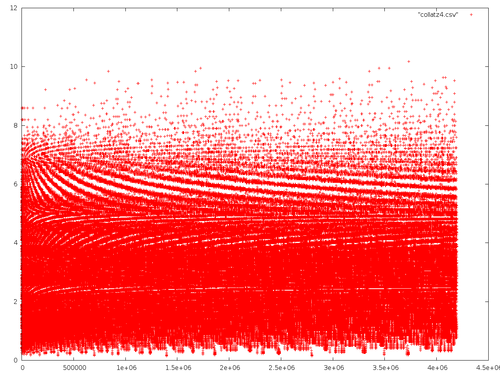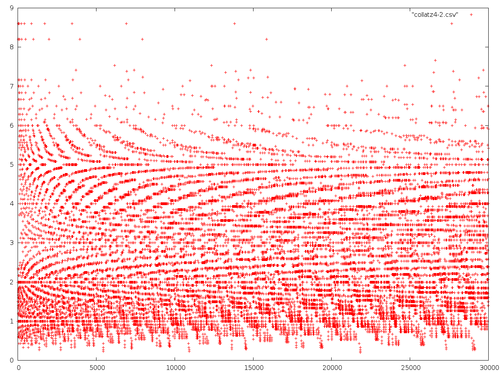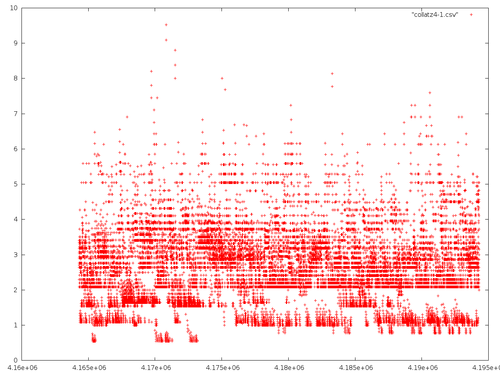Experiments on Collatz Lengths (Continued)
Description of the problem
Today, I will continue on my experiments on Collatz sequences. Here is the setup: I have the following function \[ f(n) = \begin{cases} 1 & \text{ if } n=1\\ f(n/2) & \text{ if $n$ is even }\\ 3n+1 & \text{ otherwise} \end{cases} \] I am primarily interested in the behaviour of the recursive sequence \(a_{n+1} = f(a_n)\) for different initial values \(a_0\). The conjecture is that this sequence stabilizes at 1 for every initial value \(a_0\). One of the numbers I am interested in is the length of the recursive sequence before it hits 1. \[ len(a) = \min\{n\|\ a_n = 1 \text{ when } a_0 = a \} \] Now, I would like to add another function to the mix. Let me define a new function \[ \ell(n) = \begin{cases} \ell(n/2) & \text{ if $n$ is even }\\ 1+\lfloor \log_2(n) \rfloor & \text{ if $n$ is odd}\\ \end{cases} \] Notice that the fact that our recursive sequence stabilizes at 1 is equivalent to the fact that \(\ell(a_n)\) is eventually 1.
Today, I would like to look at the distribution of \(len(a)/\ell(a)\).
Implementation
First, I will need the base function.
(defun f(n)
(cond ((equal n 1) 1)
((evenp n) (f (/ n 2)))
(t (1+ (* 3 n)))))Now, the \(\ell\) function
(defun ell (n)
(cond ((equal n 1) 1)
((evenp n) (ell (/ n 2)))
(t (1+ (floor (log n 2))))))And finally an iterator implemented with a rudimentary memoization
(defparameter iter-table (make-hash-table :test 'equal))
(defun iter-lookup (n)
(gethash n iter-table))
(defun iter-push (n val)
(setf (gethash n iter-table) val))
(defun iter (n)
(if (equal n 1)
1
(or (iter-lookup n)
(iter-push n (1+ (iter (f n)))))))Let me display the results between 1 and \(2^{22} = 4194304\). I used the following helper code to generate the sequence:
(with-open-file (results "collatz4.csv"
:direction :output
:if-exists :supersede
:if-does-not-exist :create)
(loop for i from 1 to (expt 2 22) do
(format results "~A ~A~%" i (/ (len i) (ell i) 1.0))))I passed the resulting file through gnuplot and got the following graph:

which is not very comprehensible. So, here is the first 30000 terms

and the last 30000 terms

Another Implementation in Julia
I just realized I haven’t coded in Julia in a while. So, here is an implementation of the code above in julia.
function f(n)
if n == 1 then
return 1
elseif mod(n,2) == 0 then
return f(n/2)
else
return 3*n+1
end
end
function iter(n)
if n == 1 then
return 1
else
return 1+iter(f(n))
end
end
function ell(n)
if n == 1 then
return 1
elseif mod(n,2) == 0 then
return ell(n/2)
else
return 1+floor(log(n)/log(2))
end
end
A = [(i,iter(i)/ell(i)) for i in 1:4194304]The julia code above took about 60 seconds to run on my dinky laptop with its Intel® Core™ i5-2430M CPU and 4Gb of RAM. The lisp code on sbcl took about 23 seconds on the same machine :) Ok, I am cheating of course since the lisp code cuts down the computation time using a basic memoization trick. But still, sbcl has been pleasantly surprising me with its superior performance in numerical calculations.